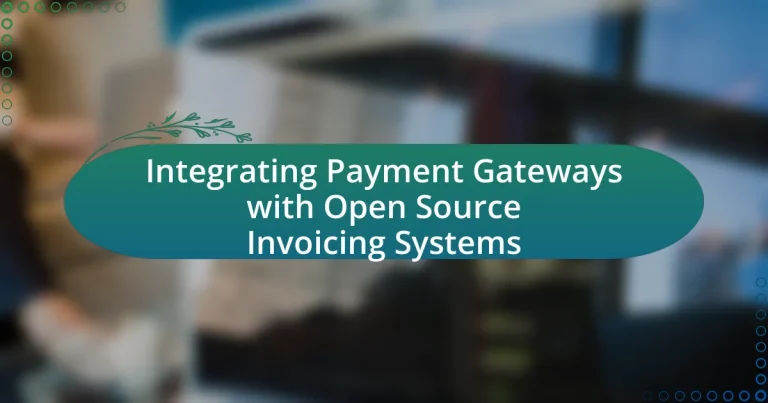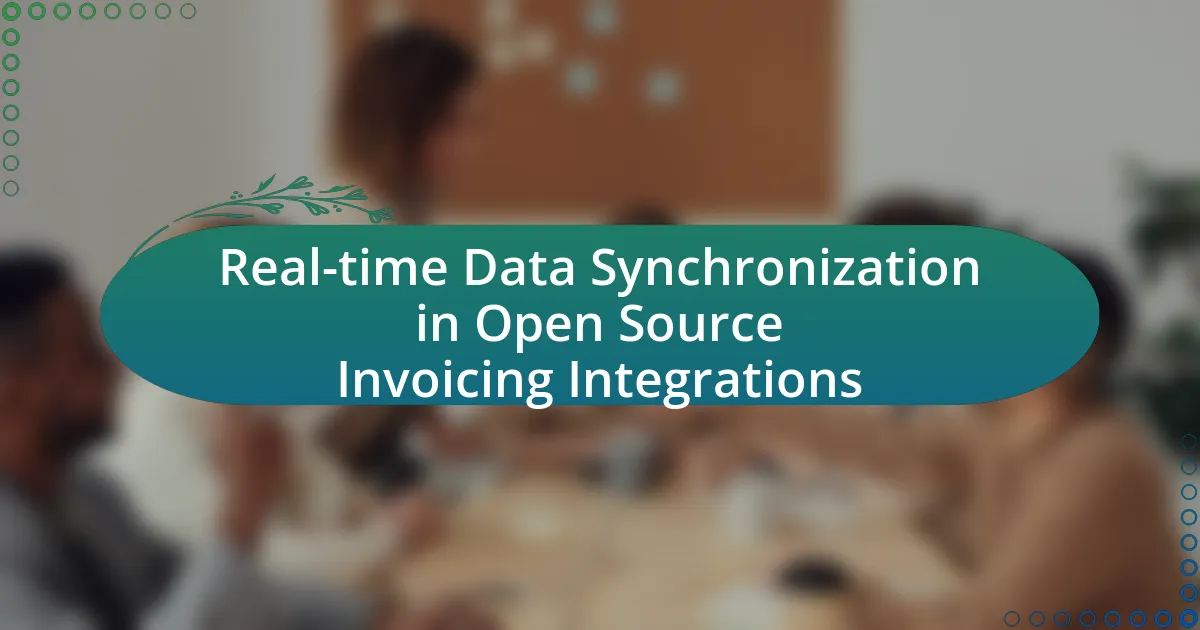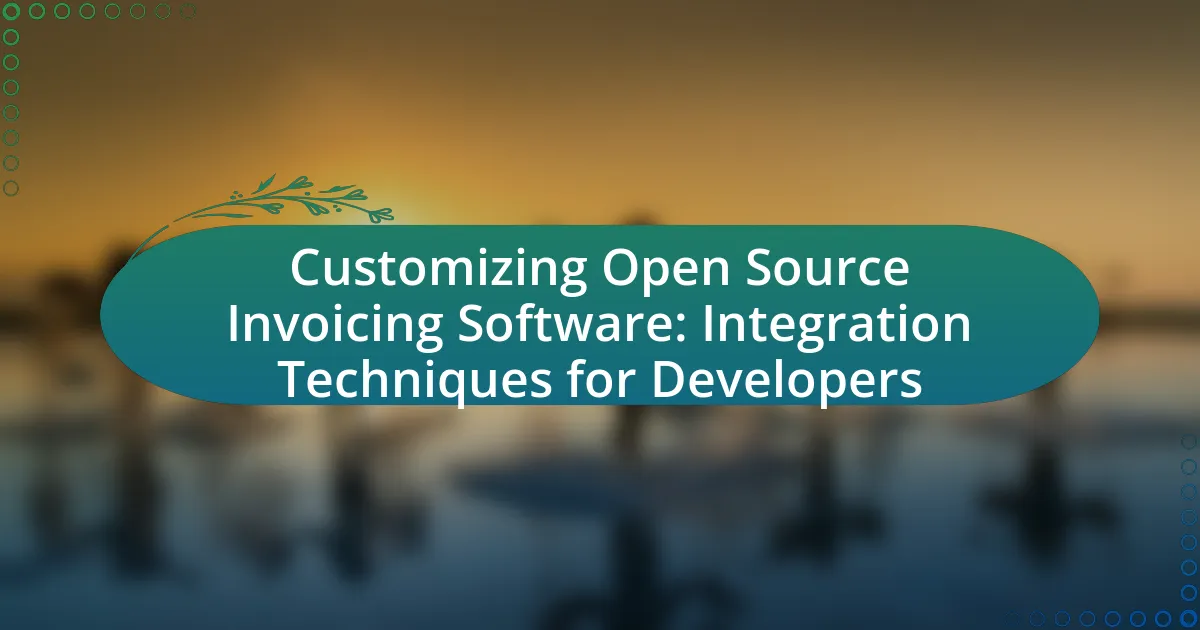Integrating payment gateways with open source invoicing systems involves connecting payment processing services to publicly accessible invoicing software, enabling automated payment collection and improved cash flow management. This integration enhances user experience by allowing customers to pay invoices directly through the invoicing platform, while also reducing manual entry errors. Key components of payment gateways include payment processors, merchant accounts, and security features, all of which work together to facilitate secure online transactions. The article discusses the advantages of this integration, such as increased efficiency and cost savings, as well as challenges like compatibility issues and security concerns, providing best practices for successful implementation and maintenance.
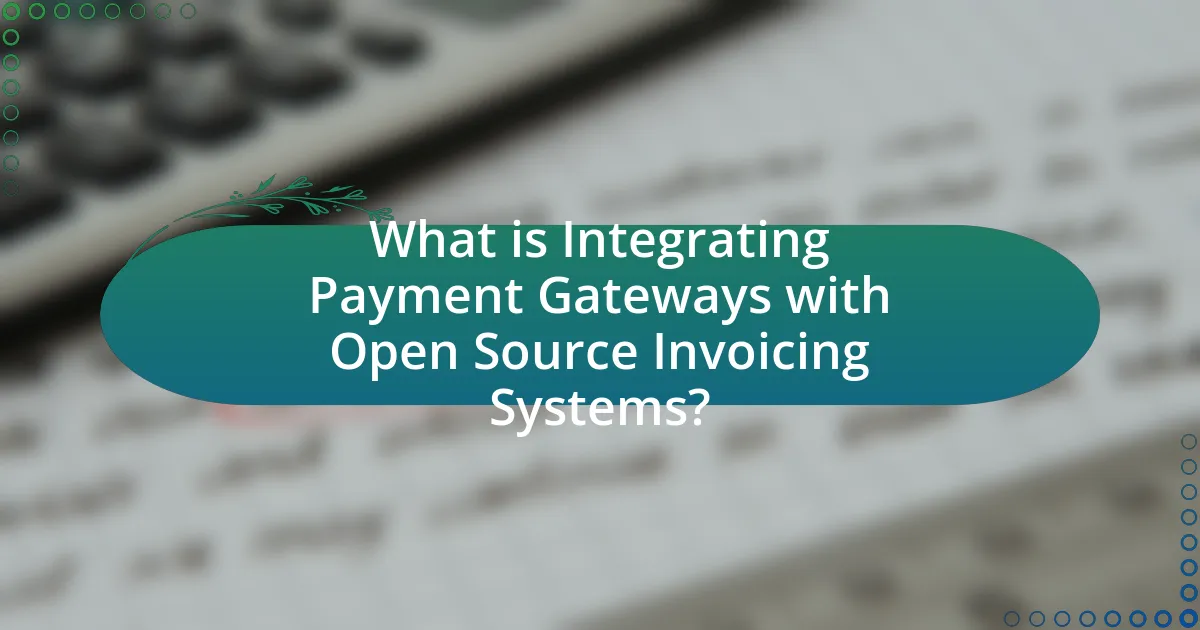
What is Integrating Payment Gateways with Open Source Invoicing Systems?
Integrating payment gateways with open source invoicing systems involves connecting various payment processing services to invoicing software that is publicly accessible and modifiable. This integration allows businesses to automate payment collection, streamline financial transactions, and enhance user experience by enabling customers to pay invoices directly through the invoicing platform. For instance, popular open source invoicing systems like Invoice Ninja or Dolibarr can be integrated with payment gateways such as PayPal or Stripe, facilitating real-time payment processing and improving cash flow management. This capability is essential for businesses seeking to optimize their invoicing processes and reduce manual entry errors, ultimately leading to increased efficiency and customer satisfaction.
How do payment gateways function within open source invoicing systems?
Payment gateways function within open source invoicing systems by facilitating the secure processing of online payments. These gateways act as intermediaries between the invoicing system and financial institutions, enabling transactions to be completed efficiently. When a customer initiates a payment, the invoicing system sends the transaction details to the payment gateway, which encrypts the information and forwards it to the appropriate bank or payment processor for authorization. Once the transaction is approved, the payment gateway communicates the result back to the invoicing system, allowing the system to update the invoice status accordingly. This integration ensures that sensitive payment information is handled securely, complying with standards such as PCI DSS, which mandates strict security measures for processing card payments.
What are the key components of a payment gateway?
The key components of a payment gateway include the payment processor, merchant account, payment gateway software, and security features. The payment processor facilitates the transaction between the customer’s bank and the merchant’s bank, ensuring funds are transferred securely. A merchant account is necessary for businesses to accept payments, acting as an intermediary account that holds funds before they are transferred to the business’s bank account. Payment gateway software provides the interface for customers to enter their payment information and initiates the transaction process. Security features, such as encryption and compliance with standards like PCI DSS, protect sensitive customer data during transactions. These components work together to ensure efficient, secure, and reliable payment processing for online transactions.
How do these components interact with open source invoicing systems?
Payment gateways interact with open source invoicing systems by facilitating the processing of transactions and automating payment collection. These components work together to ensure that invoices generated by the open source system can be paid electronically, allowing for seamless financial operations. For instance, when a customer receives an invoice, the payment gateway enables them to complete the transaction online, which is then reflected in the invoicing system in real-time. This integration enhances efficiency, reduces manual entry errors, and provides immediate payment confirmation, thus streamlining the overall invoicing process.
What are the advantages of integrating payment gateways with open source invoicing systems?
Integrating payment gateways with open source invoicing systems enhances transaction efficiency and improves cash flow management. This integration allows businesses to automate payment processing, reducing manual errors and saving time. Furthermore, it provides customers with multiple payment options, increasing the likelihood of completed transactions. According to a study by the Federal Reserve, businesses that streamline payment processes can see a reduction in payment cycle times by up to 30%. Additionally, open source systems often allow for customization, enabling businesses to tailor the integration to their specific needs, which can lead to improved user experience and satisfaction.
How does this integration enhance user experience?
This integration enhances user experience by streamlining the payment process within open source invoicing systems. By allowing users to make payments directly through the invoicing interface, it reduces friction and minimizes the steps required to complete a transaction. Research indicates that streamlined payment processes can lead to a 30% increase in conversion rates, as users are less likely to abandon their carts when faced with fewer obstacles. Additionally, integrating payment gateways provides real-time transaction updates, improving transparency and user trust, which are critical factors in user satisfaction.
What cost benefits can businesses expect from this integration?
Businesses can expect significant cost benefits from integrating payment gateways with open source invoicing systems, primarily through reduced transaction fees and lower operational costs. By utilizing open source solutions, companies often avoid hefty licensing fees associated with proprietary software, leading to substantial savings. Additionally, many open source invoicing systems offer customizable features that can streamline payment processes, reducing the time and resources spent on manual invoicing and payment reconciliation. For instance, a study by the International Journal of Information Management found that businesses using integrated systems reported a 30% decrease in administrative costs related to invoicing and payment processing. This integration not only enhances efficiency but also allows businesses to allocate resources more effectively, ultimately improving their bottom line.
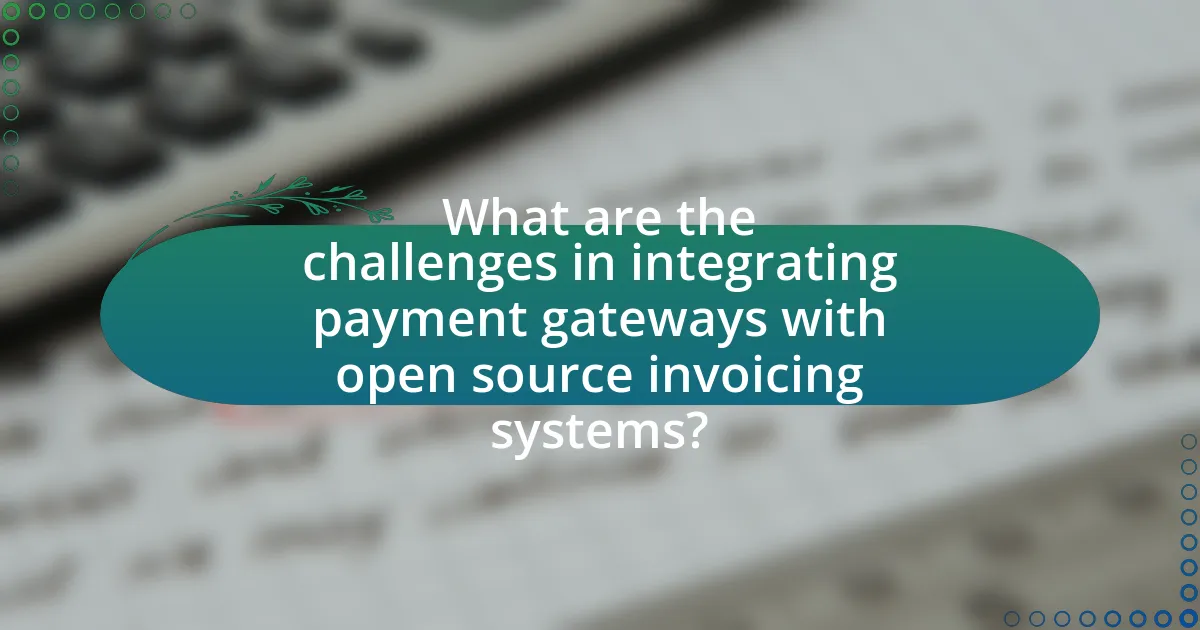
What are the challenges in integrating payment gateways with open source invoicing systems?
Integrating payment gateways with open source invoicing systems presents several challenges, including compatibility issues, security concerns, and lack of support. Compatibility issues arise because different payment gateways may not seamlessly integrate with all open source platforms, leading to potential functionality problems. Security concerns are significant, as handling sensitive payment information requires robust encryption and compliance with standards like PCI DSS, which may not be adequately addressed in some open source solutions. Additionally, the lack of dedicated support for open source systems can complicate troubleshooting and maintenance, as users may rely on community forums rather than professional assistance. These challenges highlight the complexities involved in ensuring a smooth and secure integration process.
What common technical issues arise during integration?
Common technical issues that arise during integration of payment gateways with open source invoicing systems include compatibility problems, data synchronization errors, and security vulnerabilities. Compatibility problems often occur when the payment gateway’s API does not align with the invoicing system’s architecture, leading to failed transactions. Data synchronization errors can arise when there is a mismatch in data formats or when updates in one system are not reflected in the other, causing discrepancies in financial records. Security vulnerabilities may emerge if the integration does not adhere to best practices, potentially exposing sensitive customer information to unauthorized access. These issues highlight the importance of thorough testing and adherence to integration standards to ensure seamless functionality.
How can these technical issues be resolved?
Technical issues in integrating payment gateways with open source invoicing systems can be resolved by implementing thorough testing protocols, ensuring compatibility between the systems, and utilizing robust APIs. Testing protocols, such as unit and integration tests, help identify and rectify issues before deployment. Compatibility can be ensured by selecting payment gateways that support the specific open source invoicing system being used, as evidenced by successful integrations documented in developer forums. Robust APIs facilitate seamless communication between the invoicing system and the payment gateway, reducing the likelihood of errors during transactions.
What security concerns should be addressed during integration?
During the integration of payment gateways with open source invoicing systems, key security concerns include data encryption, secure API access, and compliance with standards such as PCI DSS. Data encryption ensures that sensitive information, like credit card details, is protected during transmission and storage, reducing the risk of data breaches. Secure API access involves implementing authentication mechanisms, such as OAuth, to prevent unauthorized access to payment processing functions. Compliance with PCI DSS is crucial, as it sets the security standards for organizations that handle card payments, ensuring that they maintain a secure environment for processing transactions. Addressing these concerns is essential to safeguard customer information and maintain trust in the invoicing system.
How can businesses choose the right payment gateway for their open source invoicing system?
Businesses can choose the right payment gateway for their open source invoicing system by evaluating factors such as transaction fees, integration capabilities, security features, and customer support. Transaction fees vary significantly among gateways; for instance, PayPal charges around 2.9% plus $0.30 per transaction, while Stripe offers similar rates, making cost a crucial consideration. Integration capabilities are essential, as some gateways provide plugins or APIs specifically designed for popular open source invoicing systems like Invoice Ninja or Dolibarr, facilitating smoother implementation. Security features, including PCI compliance and fraud detection, are vital to protect sensitive customer data; for example, gateways like Authorize.Net and Braintree are known for robust security measures. Lastly, reliable customer support can significantly impact the user experience, with providers like Square offering 24/7 assistance, which can be critical during technical issues. By assessing these factors, businesses can make informed decisions that align with their operational needs and customer expectations.
What factors should be considered when selecting a payment gateway?
When selecting a payment gateway, factors such as transaction fees, security features, integration capabilities, and customer support should be considered. Transaction fees can vary significantly between providers, impacting overall costs; for instance, some gateways charge a percentage per transaction while others have flat fees. Security features are crucial, as gateways must comply with PCI DSS standards to protect sensitive customer data. Integration capabilities are important to ensure compatibility with existing open source invoicing systems, allowing for seamless operations. Lastly, reliable customer support is essential for resolving issues quickly, which can affect business operations.
How do different payment gateways compare in terms of features and fees?
Different payment gateways vary significantly in features and fees, impacting their suitability for businesses. For instance, PayPal offers features like buyer protection and easy integration but charges transaction fees ranging from 2.9% + $0.30 per transaction. Stripe provides customizable payment solutions and supports multiple currencies, with fees also at 2.9% + $0.30 per transaction. Square, known for its point-of-sale systems, charges similar fees but includes additional features like inventory management. In contrast, Authorize.Net has a monthly fee of $25 plus transaction fees, offering robust fraud protection and recurring billing options. These differences in features and fees can influence a business’s choice of payment gateway based on their specific needs and transaction volumes.
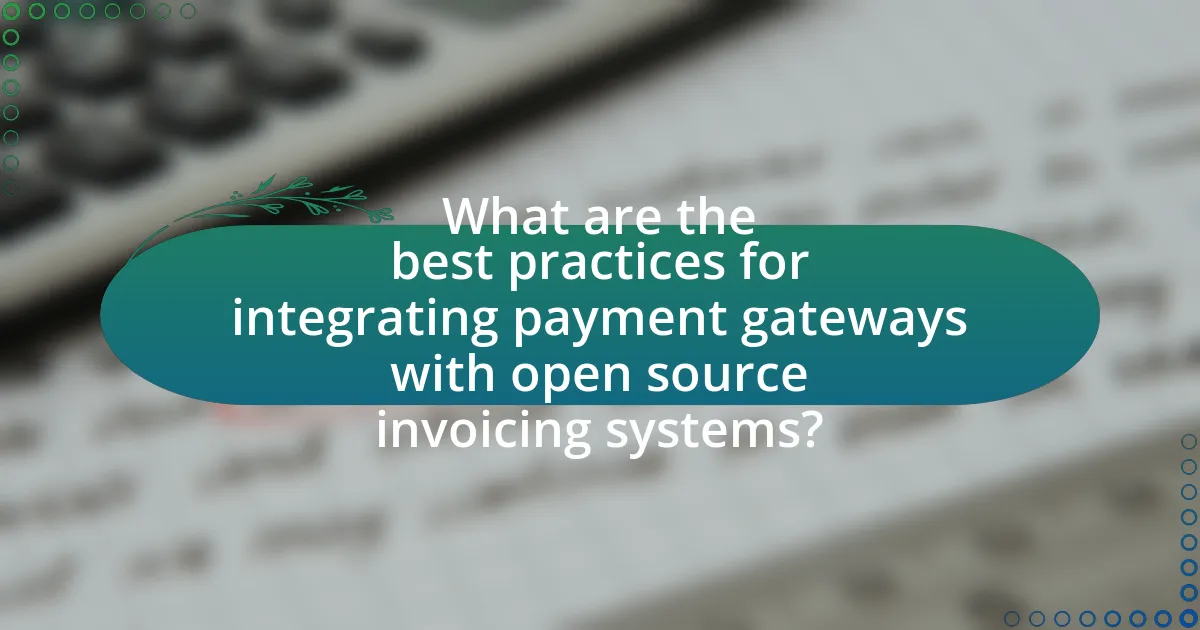
What are the best practices for integrating payment gateways with open source invoicing systems?
The best practices for integrating payment gateways with open source invoicing systems include ensuring compatibility, implementing secure API connections, and providing a seamless user experience. Compatibility is crucial; the chosen payment gateway must support the specific open source invoicing system being used, as evidenced by the documentation provided by both the invoicing software and the payment gateway. Secure API connections are essential to protect sensitive financial data; using HTTPS and adhering to PCI DSS standards mitigates risks associated with data breaches. Additionally, a seamless user experience can be achieved by customizing the payment interface to match the invoicing system’s design, which enhances customer satisfaction and reduces cart abandonment rates. These practices are supported by industry standards and user feedback, demonstrating their effectiveness in successful integrations.
How can businesses ensure a smooth integration process?
Businesses can ensure a smooth integration process by conducting thorough planning and testing before implementation. This involves defining clear objectives, selecting compatible payment gateways, and ensuring that the open-source invoicing system supports the chosen gateway’s API. According to a study by the Payment Card Industry Security Standards Council, 70% of integration issues arise from inadequate testing and planning. Therefore, businesses should allocate sufficient resources for testing in various scenarios to identify potential issues early, ensuring a seamless user experience and operational efficiency.
What steps should be taken to test the integration thoroughly?
To test the integration of payment gateways with open source invoicing systems thoroughly, follow these steps: first, establish a comprehensive test plan that outlines the objectives, scope, and resources needed for testing. Next, conduct unit testing to verify that individual components function correctly. After that, perform integration testing to ensure that the payment gateway interacts seamlessly with the invoicing system. Subsequently, execute end-to-end testing to simulate real-world scenarios, confirming that transactions process correctly from initiation to completion. Additionally, carry out performance testing to assess the system’s responsiveness and stability under load. Finally, implement security testing to identify vulnerabilities and ensure compliance with data protection regulations. These steps are validated by industry best practices, which emphasize the importance of a structured testing approach to mitigate risks and enhance system reliability.
How can businesses maintain and update their integration over time?
Businesses can maintain and update their integration over time by implementing regular monitoring, adopting flexible architecture, and ensuring continuous training for staff. Regular monitoring allows businesses to identify issues promptly, while flexible architecture enables easy adaptation to new technologies or changes in payment gateway APIs. Continuous training ensures that employees are equipped with the latest knowledge and skills to manage integrations effectively. For instance, a study by McKinsey & Company highlights that organizations that invest in ongoing training and development see a 20% increase in operational efficiency, which directly supports the maintenance of integration systems.
What resources are available for troubleshooting integration issues?
Resources available for troubleshooting integration issues include official documentation, community forums, and technical support services. Official documentation provides detailed guidelines and troubleshooting steps specific to the payment gateway and invoicing system being used. Community forums, such as Stack Overflow or GitHub discussions, allow users to share experiences and solutions related to similar integration challenges. Additionally, many payment gateway providers offer dedicated technical support teams that can assist with complex issues, ensuring that users have access to expert help when needed.
Where can businesses find community support for open source invoicing systems?
Businesses can find community support for open source invoicing systems on platforms such as GitHub, where many projects host their repositories and discussions. These platforms often feature issue trackers, forums, and community discussions that facilitate collaboration and problem-solving among users and developers. Additionally, online communities like Stack Overflow and specialized forums dedicated to open source software provide valuable insights and assistance. According to a 2021 survey by GitHub, over 80% of developers engage with community forums for troubleshooting and support, highlighting the effectiveness of these platforms in fostering collaboration and knowledge sharing.
What documentation is essential for successful integration?
Essential documentation for successful integration of payment gateways with open source invoicing systems includes API documentation, integration guides, and security compliance documentation. API documentation provides detailed information on how to interact with the payment gateway, including endpoints, request formats, and response structures. Integration guides offer step-by-step instructions tailored to specific open source invoicing systems, ensuring that developers can implement the integration correctly. Security compliance documentation outlines the necessary measures to protect sensitive data, such as PCI DSS requirements, which are critical for maintaining customer trust and regulatory compliance.
